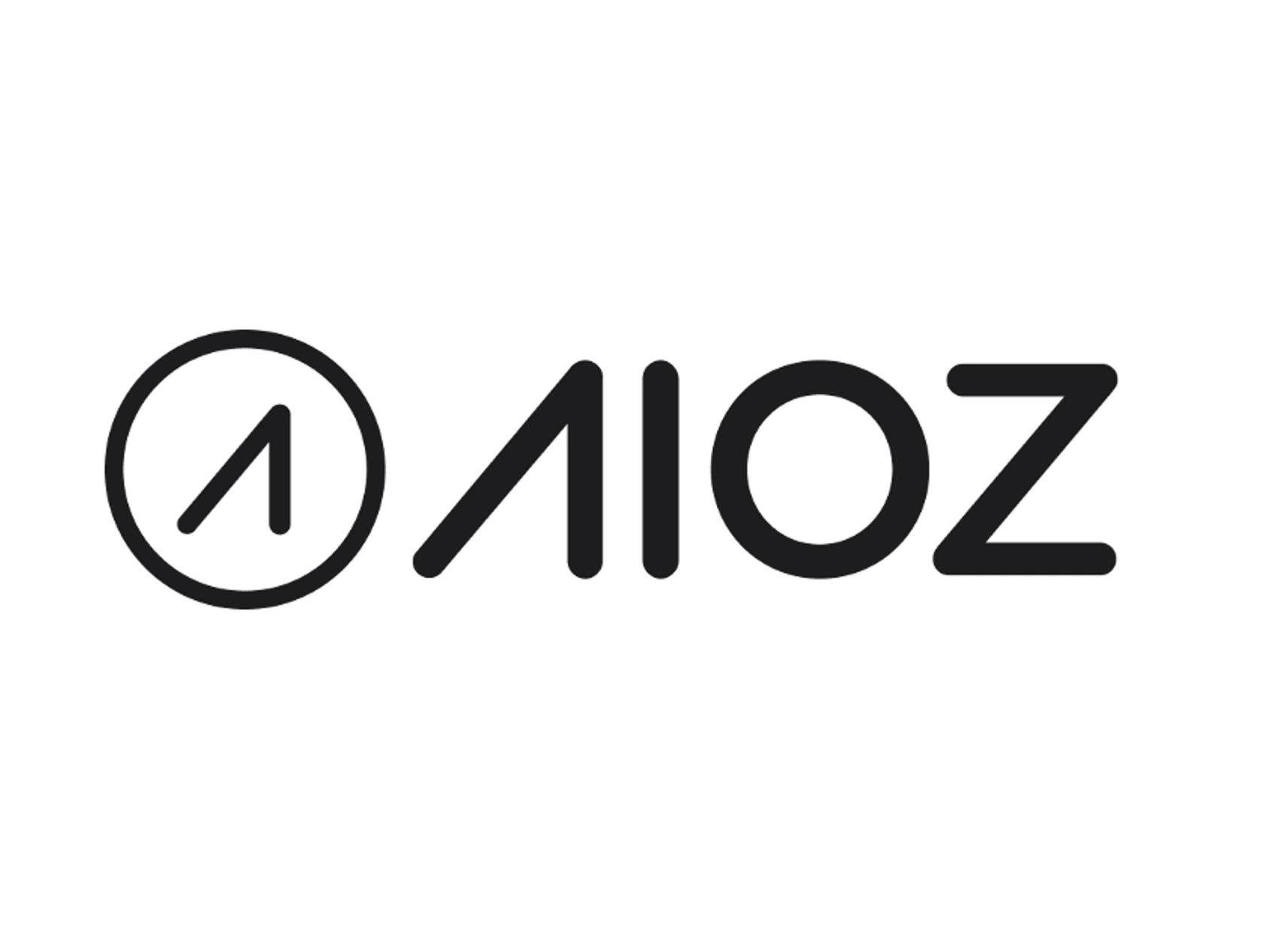위키 구독하기
Share wiki
Bookmark
AIOZ Network
AIOZ Network
AIOZ 네트워크(AIOZ Network)는 Erman Tjiputra가 설립하고 싱가포르에 본사를 둔, 웹3 스토리지, 분산형 AI 컴퓨팅 및 비디오 서비스를 위한 인프라 솔루션으로 기능합니다. 변화하는 디지털 환경에서 파일 저장 및 콘텐츠 전달에 대한 전 세계적인 수요 증가에 대응하는 것을 목표로 합니다.[1][2]
개요
2018년에 설립된 AIOZ 네트워크는 피어투피어 에지 노드에 의해 구동되는 계층 1 상호 운용 가능한 멀티체인 Web3 콘텐츠 전송 네트워크로 기능합니다. 36,000개 이상의 에지 노드와 AIOZ Tube에서의 상당한 사용자 참여를 통해 플랫폼은 저장 및 스트리밍 과제를 해결하고자 합니다. AIOZ 네트워크는 블록체인 및 dCDN 구성 요소를 통해 dApps을 지원하는 Web3 인프라입니다.[1][3]
AIOZ 블록체인
AIOZ 네트워크의 블록체인은 코스모스(Cosmos)와 이더리움 가상 머신(EVM, Ethereum Virtual Machine)의 요소를 결합하여 효율성과 적응성을 강조합니다. 텐더민트(Tendermint) 코어와 위임 지분 증명(dBFT)(delegated Proof of Stake (dBFT))을 사용하여 탈중앙화 애플리케이션(dApps)을 지원하며, 간소화된 트랜잭션과 확장성을 저렴한 비용으로 제공합니다. 다중 체인 설계는 다양한 EVM 체인 및 코스모스 기반 체인과의 통합을 가능하게 하여 서로 다른 블록체인 생태계 간의 자산 및 데이터 전송을 촉진하고자 합니다. 이 플랫폼은 Solidity 및 Web Assembly와 같은 표준 스마트 계약 언어를 지원하여 개발자에게 크로스 플랫폼 애플리케이션 개발의 유연성을 제공합니다.[4][5]
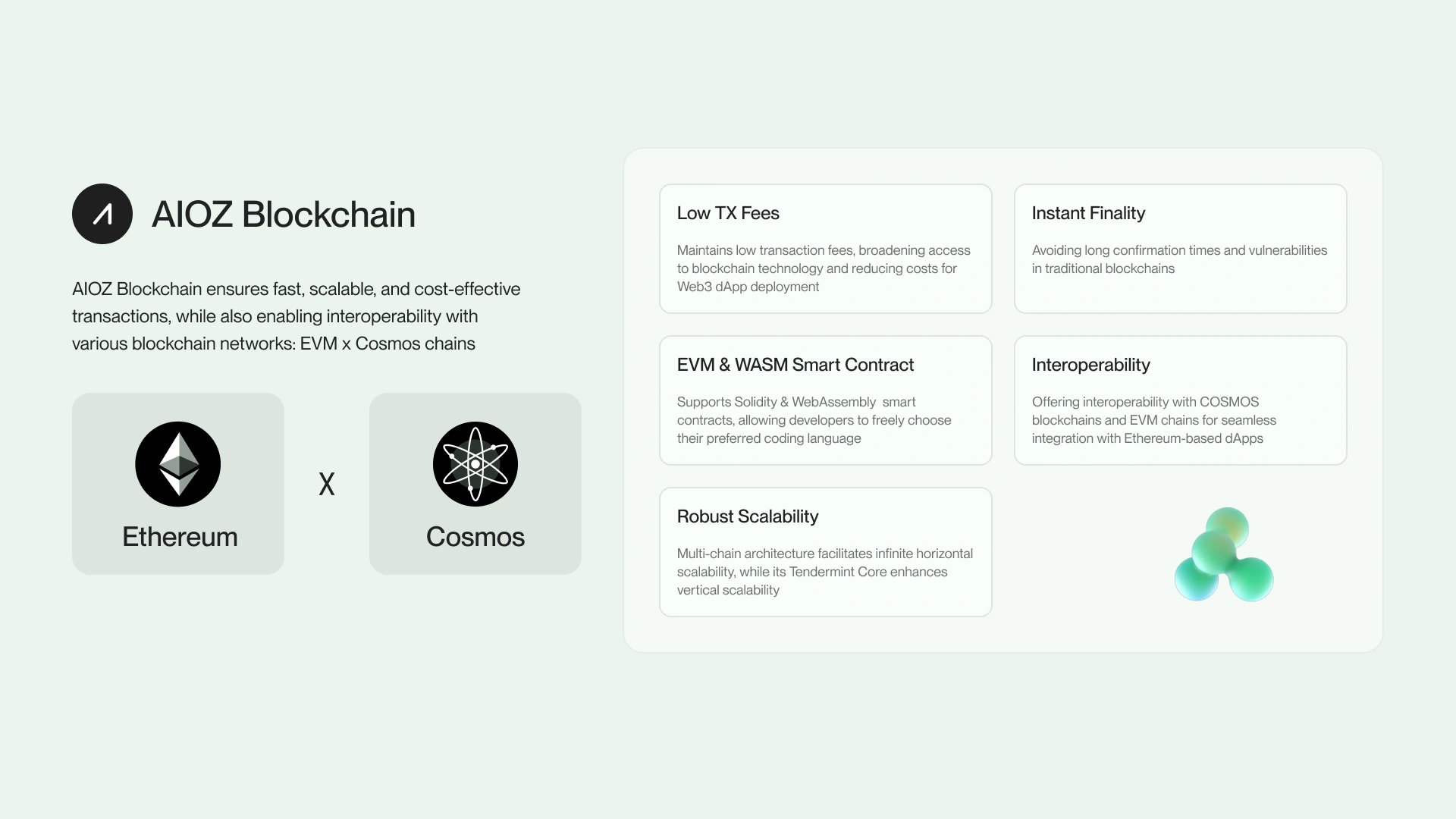
AIOZ dCDN
AIOZ Network의 dCDN 플랫폼은 웹 3.0 dApp을 위한 경제적인 파일 저장 및 배포의 어려움을 해결하고자 합니다. AIOZ 에지 노드와 피어투피어(peer-to-peer) 노드를 활용하여 플랫폼은 효율적이고 비용 효과적인 콘텐츠 전송을 구축하고자 하며, 참여자는 $AIOZ 토큰으로 보상을 받을 수 있습니다. $AIOZ 토큰으로 인센티브를 받은 참여자들은 AIOZ 에지 노드를 통해 플랫폼의 안전하고 분산된 콘텐츠 전송이라는 목표 달성에 기여하도록 장려됩니다. 메타버스 공간에서 AIOZ Network dCDN은 고대역폭, 저지연, 비용 효과적인 콘텐츠 전송을 지원하여 잠재적인 몰입형 경험을 촉진하고 dApp 내 가상 환경의 발전에 기여하고자 합니다.[6][7]
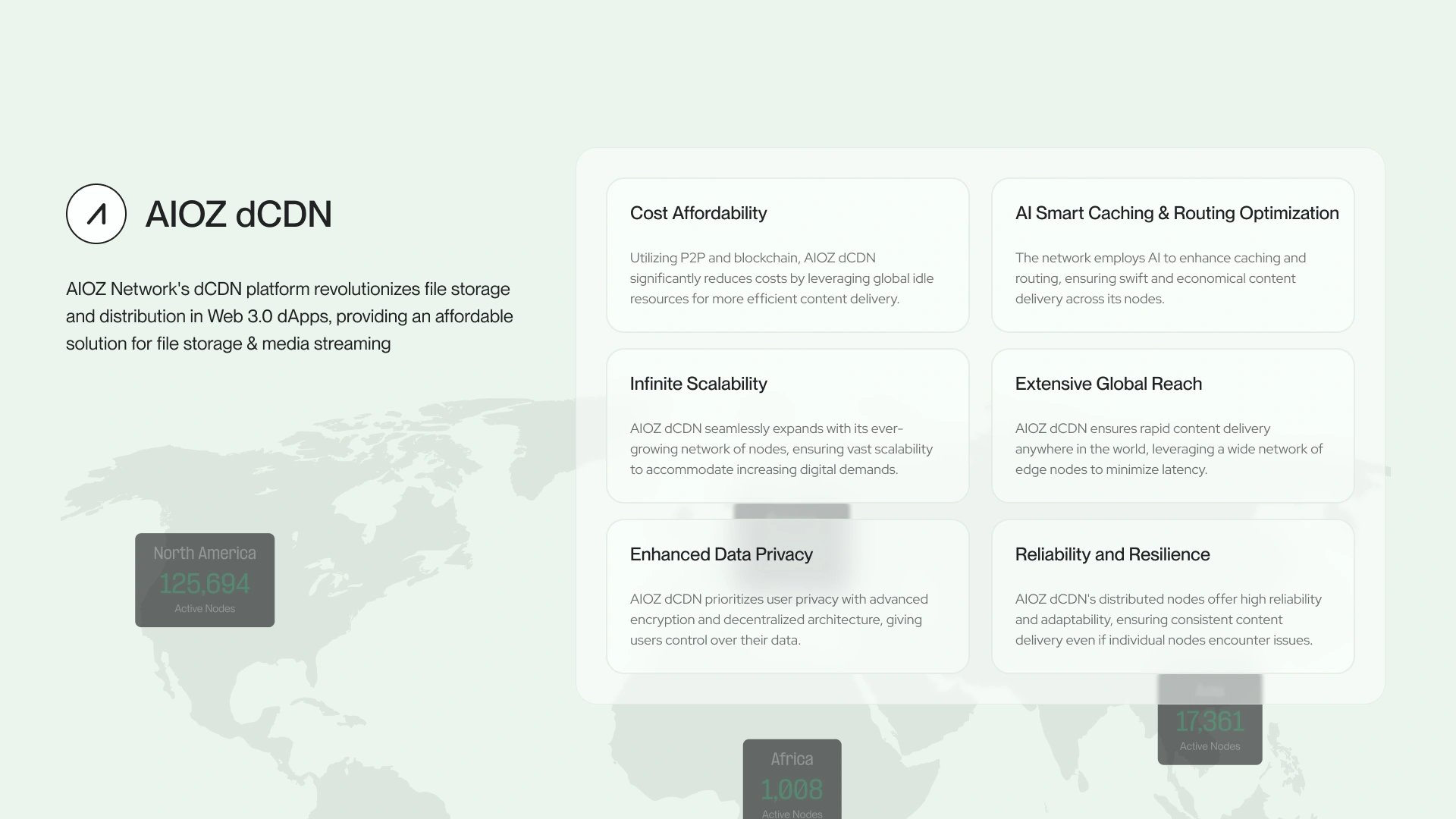
AOIZ Web3 서비스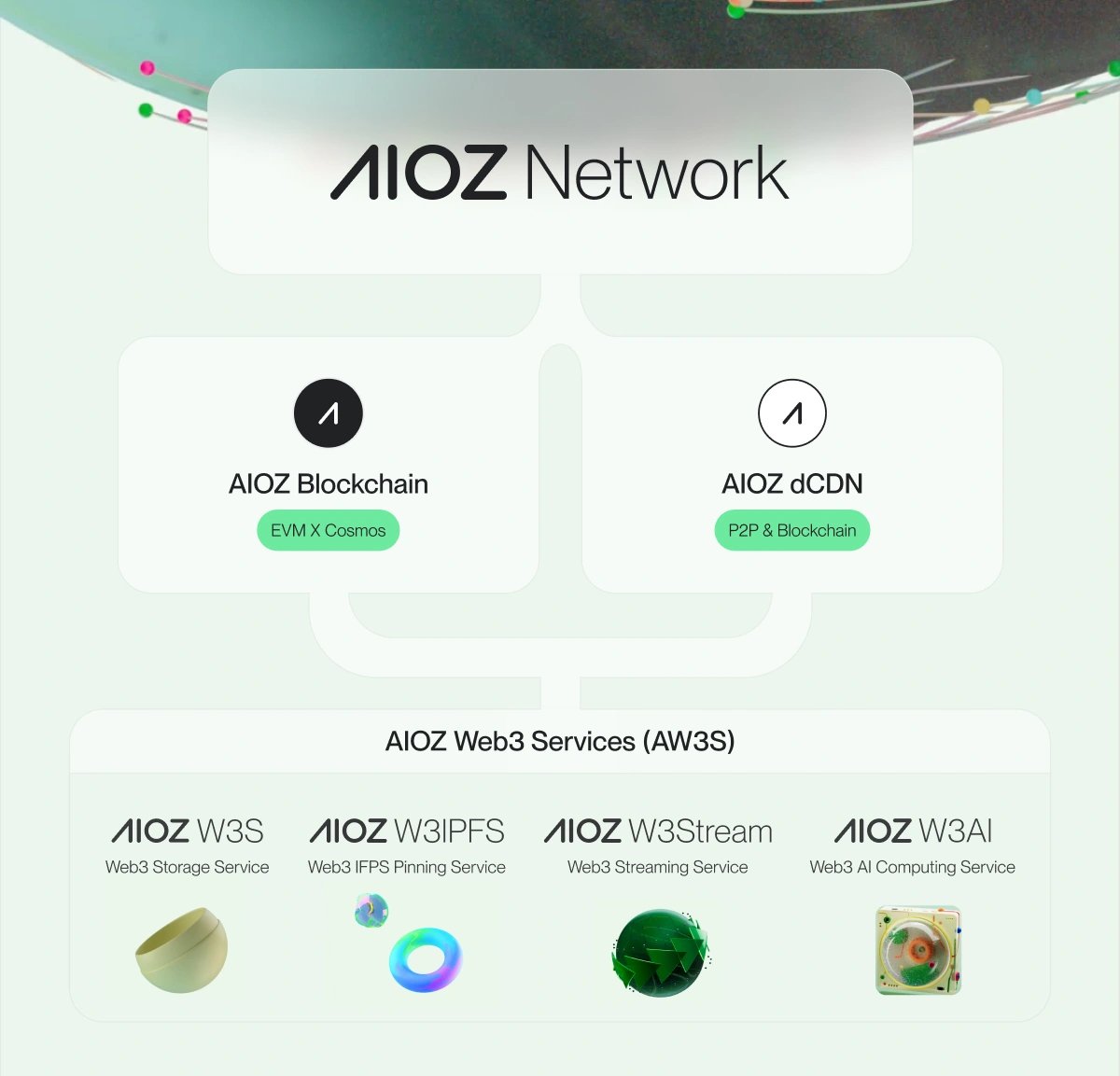

AIOZ Web3 스토리지
AIOZ Web3 스토리지(W3S)는 Web3 탈중앙화 애플리케이션(dApps)과 호환되는 S3 호환 객체 스토리지 인프라로서 기능합니다. AIOZ 네트워크의 탈중앙화 기능과 피어 투 피어 네트워킹을 활용하여 AIOZ W3S는 안전하고, 분산되며, 비용 효율적인 클라우드 객체 스토리지를 제공하는 것을 목표로 합니다.[8][9]
특징
AIOZ Web3 스토리지(W3S)는 아마존의 Simple Storage Service(AWS S3)와 원활하게 통합되어 사용자에게 유연성을 제공하는 것을 목표로 합니다. 분산된 접근 방식을 사용하여 W3S는 글로벌 데이터 가용성을 보장하고 단일 장애 지점의 위험을 최소화하려고 합니다. 탈중앙화 네트워크의 과제를 해결하기 위해 W3S는 효율적인 데이터 액세스를 우선시하여 운영 효율성을 향상시키는 데 기여합니다. 확장성을 고려한 설계로 사용자의 변화하는 스토리지 요구에 적응할 수 있습니다. W3S의 탈중앙화 구조는 고급 암호화를 통해 사용자 개인 정보를 강화하고 사용자의 데이터 액세스 제어를 강조합니다. AIOZ 네트워크의 글로벌 P2P 노드를 활용하여 W3S는 내장형 콘텐츠 전송 네트워크(CDN) 역할을 하여 추가 비용 없이 데이터 전송을 용이하게 합니다. 플랫폼의 투명한 가격 정책은 사용자의 예산 편성을 간소화합니다. 또한 W3S는 AIOZ 토큰으로 결제를 도입하여 사용자에게 종량제 모델로 거래를 간소화하고 비용 효율성을 강조합니다.[8][9]
용도
AIOZ Web3 스토리지는 다양한 분야에서 실용적인 응용 프로그램을 제공합니다. 미디어 및 엔터테인먼트 회사의 상당한 콘텐츠에 대한 안전한 저장소를 제공하고 전자상거래 플랫폼에 대한 높은 가용성과 신속한 전달을 제공하는 것을 목표로 합니다. 탈중앙화 애플리케이션(DApps)의 경우 AIOZ Web3 스토리지는 탈중앙화된 생태계 내에서 안정적인 저장소를 제공하려는 반면, 블록체인 프로젝트는 탈중앙화되고 불변의 저장 솔루션에 활용할 수 있습니다. 의료 분야에서 AIOZ Web3 스토리지는 의료 데이터 규정에 따라 민감한 의료 데이터의 안전한 저장을 보장하고자 합니다. 데이터 중심의 신생 기업은 대규모 데이터 세트의 저장 및 처리에 있어 확장성과 비용 효율성을 통해 이점을 얻을 수 있습니다. 클라우드 서비스 제공업체는 AIOZ Web3 스토리지를 통합하여 데이터 가용성과 안정성을 향상시킬 수 있습니다. [8][9]
AIOZ W3IPFS
Protocol Labs의 분산형 파일 시스템(IPFS)은 웹의 속도와 접근성을 향상시키도록 설계된 오픈소스 피어투피어 파일 공유 시스템입니다. 그러나 IPFS는 기술적 복잡성과 제한적인 검색 기능과 같은 과제에 직면해 있습니다. 이에 대한 해결책으로 AIOZ는 제한 없는 핀 파일, 전용 리소스, 낮은 지연 시간 및 스마트 캐싱과 같은 기능을 통해 이러한 과제를 해결하고자 AIOZ Web3 IPFS(W3IPFS)를 제안했습니다.[10]
특징
AIOZ Web3 IPFS는 IPFS에서 분산형 데이터 저장을 가능하게 하여 DApps를 위한 분산되고 안전한 저장소를 목표로 합니다. 데이터 보존을 위한 IPFS 피닝 서비스를 제공하며 NFT 업로드 및 관리를 간소화하는 것을 목표로 합니다. 이 플랫폼에는 효율적인 콘텐츠 배포를 위한 내장형 CDN과 안정적인 데이터 액세스를 위한 전용 게이트웨이가 포함되어 있습니다. 개발자는 잘 문서화된 SDK 및 API 리소스를 통해 통합을 용이하게 합니다.[10]
용도
AIOZ Web3 IPFS는 다양한 플랫폼에서 아티스트, 콘텐츠 제작자 및 디지털 미디어 제작자의 저장 요구 사항을 충족합니다. 또한 NFT 마켓플레이스에도 서비스를 제공하여 안정적이고 분산된 저장소를 제공합니다. 게다가 NFT 게임을 지원하여 게임 자산에 대한 안전한 저장소를 제공하는 것을 목표로 합니다. 메타버스 애플리케이션에서 AIOZ Web3 IPFS는 가상 경험을 위한 자산 저장에 기여합니다.[10]
AIOZ W3AI
AIOZ W3AI는 개발자와 기업을 위한 Web3 AI 컴퓨팅 인프라로서 기능하는 것을 목표로 하며, 인공지능 작업 실행 방식을 혁신하고자 합니다. 사용자 기기에서의 로컬 실행을 통해 데이터 프라이버시와 향상된 성능을 보장함으로써 사용자 중심 경험을 강조하는 분산형 AI 컴퓨팅을 가능하게 하는 것이 목표입니다. 이 플랫폼은 분산형 AI 모델 학습 기능을 제공하고, AI 모델 및 데이터 세트를 위한 마켓플레이스를 호스팅하며, AI 기반 분산형 애플리케이션(dApps) 개발을 위한 전용 공간을 만드는 것을 목표로 합니다. 이러한 다면적인 접근 방식은 모델 학습 및 안전한 데이터 세트를 위한 협업 환경을 조성하여 분산형 애플리케이션 개발에 기여하도록 설계되었습니다. [11]
특징
AIOZ W3AI는 AIOZ 노드를 통해 사용자 기기에서 로컬 처리를 가능하게 함으로써 데이터 프라이버시를 우선시하여 AI 작업 실행을 변혁하고자 합니다. 분산 컴퓨팅을 사용하여 리소스 활용 및 확장성을 최적화합니다. 이 플랫폼은 사용자 친화적인 API 및 문서를 통해 AI-as-a-Service 통합을 제공하여 원활한 모델 통합을 목표로 합니다. 사용자는 이미지 생성 및 인식과 같은 작업을 포함하는 분산형 AI-as-a-service 내에서 다양한 AI 모델에 액세스할 수 있습니다. 작업 실행에 대한 보상을 얻는 컴퓨팅 증명 메커니즘이 AIOZ 노드를 유인합니다. 이 플랫폼은 연구원들이 모델을 만들고 수익을 창출할 수 있는 분산형 AI 마켓플레이스를 구축하려고 합니다. 개인 정보 보호를 강조하여 사용자 데이터는 암호화 및 분산 저장소에 의해 보호되는 사용자 기기에 남아 있습니다. AIOZ W3AI는 수요에 따라 동적으로 확장하여 효율적인 리소스 활용을 목표로 하며, 로컬 AI 작업 실행은 지연 시간을 최소화하여 사용자 경험을 개선하려고 합니다.[11]
에지 컴퓨팅 솔루션
AIOZ W3AI는 AI 작업을 로컬에서 실행하여 지속적인 데이터 전송의 필요성을 줄임으로써 사물 인터넷(IoT)의 운영을 최적화하는 것을 목표로 합니다. 개발자는 이 플랫폼을 활용하여 AI 기반 기능을 제공하고 사용자 데이터 개인 정보 보호를 우선시할 수 있습니다. 전자상거래에서 AIOZ W3AI는 개인화된 상품 추천을 통해 사용자 경험을 향상시키고자 합니다. 또한 이 플랫폼은 AI 연구자를 위한 분산형 인프라를 제공하고 의료 분야의 AI 기반 의료 영상 분석에 기여하는 것을 목표로 합니다. 교육 분야에서는 AIOZ W3AI가 온디바이스 AI 기능을 통해 e러닝 플랫폼에서 개인화된 학습 경험을 촉진하고자 합니다.[11]
AIOZ W3Stream
AIOZ 웹3 스트리밍은 분산형 비디오 스트리밍을 위한 기반 인프라로서, 전 세계 콘텐츠 전송을 위한 필수 도구를 제공합니다. 중앙화된 플랫폼에서 흔히 발생하는 수익 배분 불균형 문제를 해결하고, 콘텐츠 제작자에게 대안을 제공하며 보다 공정한 환경을 조성하는 것을 목표로 합니다.[12]
주요 기능
AIOZ Web3 스트리밍은 비디오 호스팅, 스트리밍, 트랜스코딩, 관리 및 분석을 위한 필수 인프라를 제공합니다. HLS 및 MPEG-DASH와 같은 인기 있는 스트리밍 프로토콜을 지원하여 광범위한 호환성을 보장하고자 합니다. 전략적으로 배치된 에지 노드를 활용하는 분산형 콘텐츠 전송 네트워크(dCDN)를 통해 지연 시간을 최소화하고 콘텐츠 전달 안정성을 향상시키는 것을 목표로 합니다. 사용자 친화적인 API, SDK 및 설명서를 통해 기업의 통합을 간소화하여 콘텐츠 제작에 집중할 수 있도록 지원합니다. 데스크톱 브라우저, 모바일 기기, 스마트 TV 및 스트리밍 미디어 플레이어를 포함한 다양한 기기와의 호환성을 위해 설계된 AIOZ Web3 스트리밍은 다양한 사용자의 선호도를 충족하고자 합니다. 비용 효율성을 우선시하여 AIOZ W3Stream은 네트워크 최적화를 통해 효율적인 비디오 전달을 제공하고자 합니다.[12]
용도
AIOZ Web3 스트리밍은 다양한 분야에서 비디오 전송을 위한 다목적 인프라를 제공하는 것을 목표로 합니다. 비디오 스트리밍 플랫폼, 미디어 기업 및 엔터테인먼트 스튜디오가 안정적인 콘텐츠 전송을 달성하도록 지원하고자 합니다. e러닝, 웨비나 및 가상 이벤트의 경우 확장성과 적응형 비트 전송률 스트리밍을 제공하고자 합니다. 콘텐츠 전송 최적화를 목표로 OTT 제공업체를 지원하고, 실시간 게임 스트림을 향상시키며, 기업의 안전한 비디오 통신을 지원합니다. 통신 회사는 대역폭 사용을 최적화하면서 비디오 서비스를 향상시키기 위해 통합을 모색할 수 있습니다.[12]
AIOZ dApps
AIOZ 네트워크(AIOZ Network)는 자체 네이티브 탈중앙화 애플리케이션(dApps)을 출시하여 자체 인프라의 기능을 강조하고자 합니다. 이러한 애플리케이션은 노드, AIOZ 블록체인, AIOZ dCDN 및 탈중앙화 AI 컴퓨팅을 통합하여 AIOZ의 글로벌 네트워크의 구조적 무결성을 보여줍니다. 주요 목표는 사용자에게 실용적인 웹3 애플리케이션을 제공하고 개발자에게 AIOZ 네트워크 기반 구축의 간편성, 경제성, 안전성 및 경제적 타당성을 보여주는 것입니다. 이러한 전략은 웹2 및 웹3 클라이언트와의 전략적 사업 개발 및 파트너십과 함께 AIOZ 네트워크 dApp, 개발자 및 파트너 생태계의 성장을 촉진하고자 합니다.[13]
크로스체인 브리지
AIOZ 네트워크 크로스체인 브리지는 이더리움 네트워크, 바이낸스 스마트 체인, 그리고 AIOZ 네트워크 간에 AIOZ 자산을 변환하기 위한 상호 운용 가능한 게이트웨이 역할을 합니다. 사용자는 AIOZ ERC-20 또는 AIOZ BEP-20 토큰을 AIOZ 네이티브 토큰으로 안전하게 브리징하고 그 반대로 할 수 있습니다. 이 기능은 인프라 서비스, 스테이킹 및 탈중앙화 애플리케이션(dApps)을 포함한 AIOZ 네트워크 생태계 내 참여를 지원하도록 설계되었습니다. AIOZ 멀티체인 자산 통합은 크로스체인 사용자 경험을 향상시키고 AIOZ 채택을 촉진하기 위한 것입니다.[19]
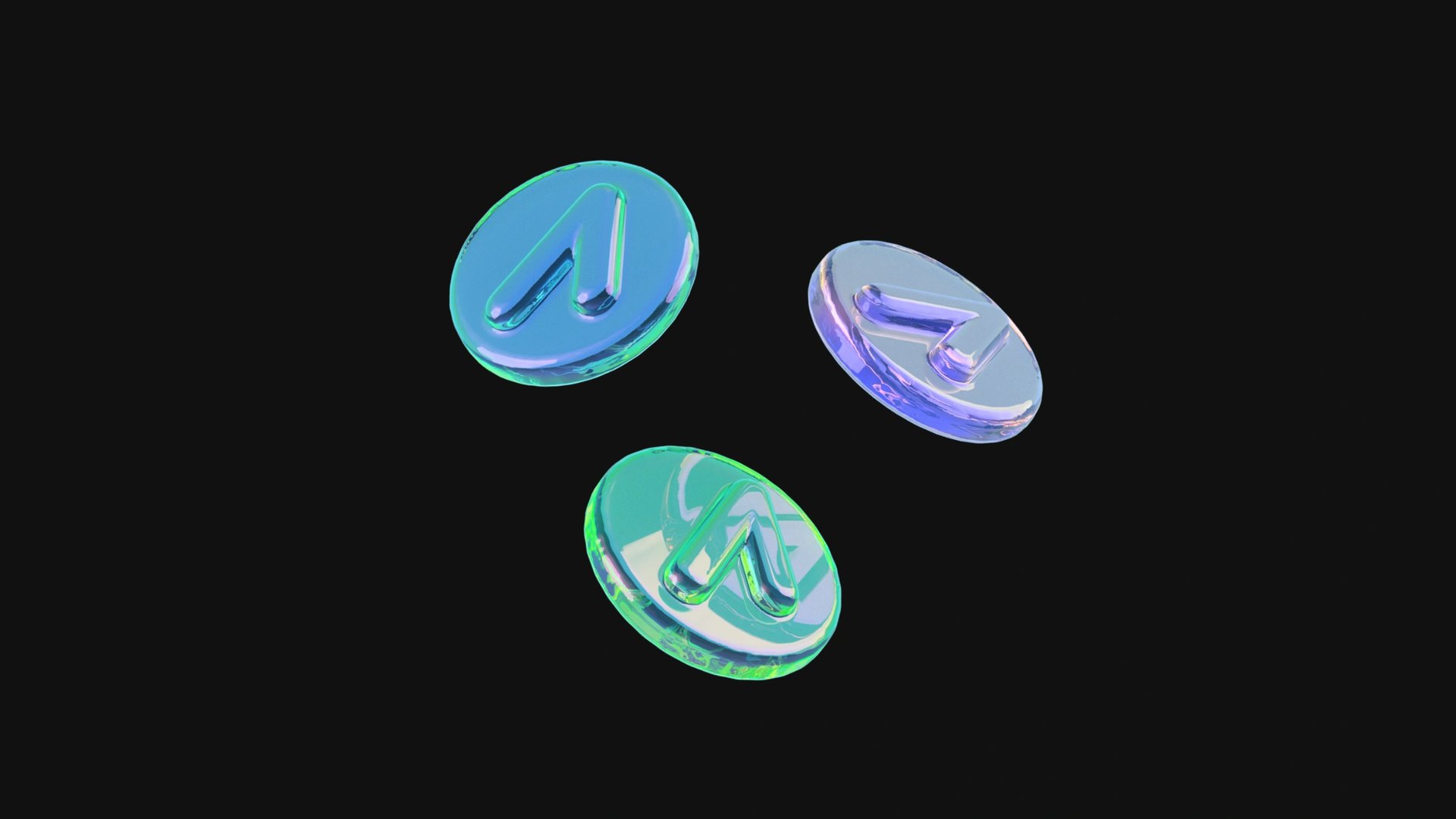 토큰 경제학 (Tokenomics)
토큰 경제학 (Tokenomics)

$AIOZ 토큰 (AIOZ Token)
$AIOZ 토큰은 AIOZ 네트워크에서 중추적인 역할을 수행하며, 디지털 콘텐츠 배포 및 컴퓨팅 프로세스 수행과 같은 작업에 대한 보상으로 에지 노드에 제공하는 것을 목표로 합니다. 핵심 기능 외에도, 이 토큰은 콘텐츠 인기도에 따라 콘텐츠 제작자에게 자동으로 보상을 제공하도록 설계된 동영상 공유 플랫폼인 AIOZ Tube와 같은 혁신적인 개념에도 관여합니다. 또한, 토큰 시스템은 광고주가 콘텐츠 제작자와 소비자에게 주의와 데이터 공유에 대한 인센티브를 제공하는 프레임워크를 제공합니다. AIOZ는 새로운 토큰 (NFT)을 통합하고 더욱 복잡하고 보상적인 시스템을 도입하여 이 모델을 개선할 계획입니다.[14]
토큰 배분
- 프라이빗 세일: 7.3%
- 퍼블릭 세일: 1.7%
- 팀: 25%
- 어드바이저: 5%
- 마케팅: 5%
- 거래소 유동성 공급: 3%
- 생태계 성장: 53%[14]
인플레이션 일정
AIOZ 네트워크의 인플레이션 일정은 다음과 같습니다.
- 2023년 12월 25일 기준 8%
- 2024년 12월 25일 기준 7%
- 2025년 12월 25일 기준 6%
- 2026년 12월 25일 기준 5%
장기적인 기준 목표를 5%로 설정하여 AIOZ 네트워크의 이해관계자에 대한 인센티브를 크게 높이는 것을 목표로 합니다. 결과적으로 발생하는 인플레이션 수익은 이전에 설정된 방식과 동일하게 배분됩니다. 50%는 Validator와 위임자에게, 나머지 50%는 재무부에 배분됩니다. 이러한 점진적인 접근 방식은 네트워크 성장과 이해관계자 보상 간의 균형을 목표로 합니다.[16]
토큰 소각
토큰 소각은 다음과 같이 구성됩니다.
이러한 체계적인 토큰 소각 전략은 네트워크의 전반적인 지속 가능성 목표와 부합하며 토큰의 장기적인 가치 제안을 강화하는 것을 목표로 합니다.[17]
AIOZ 파트너십
AIOZ x DWF Labs
2023년 3월, AIOZ 네트워크는 분산형 콘텐츠 전송 네트워크(dCDN) 비전을 위한 투자(금액 미공개)를 확보하며 DWF Labs와 파트너십을 체결했습니다. DWF Labs는 AIOZ 네트워크를 Web3 dApps의 잠재적 기반으로 보고 있습니다. AIOZ는 dCDN을 통해 구축되고 AIOZ 토큰으로 보상되는 신뢰할 수 없는 분산 미디어 공간을 구상하고 있습니다.[20]
AIOZ x Keplr
2023년 6월, AIOZ 네트워크는 탈중앙화 애플리케이션(dApps) 및 자산 관리 생태계 내에서 사용자 상호 작용을 간소화하기 위해 Keplr 지갑을 통합했습니다. 이 통합을 통해 사용자는 AIOZ 네트워크에 원활하게 참여하고 다양한 dApps에 액세스할 수 있습니다. 특히, Keplr을 사용하여 AIOZ 네트워크에서 Ethereum 가상 머신(EVM) 트랜잭션에 서명할 수 있도록 하여 Ethereum dApps (예: 탈중앙화 금융 플랫폼 및 NFT 마켓플레이스)에 대한 간소화된 액세스를 제공합니다.[21]
AIOZ x Core
2024년, AIOZ 네트워크는 Core 생태계에 통합되어 AVAX(어밸런치) 개발자들 사이에서의 가시성을 높이고 DePIN 인프라 도구에 대한 접근성을 제공하는 것을 목표로 했습니다. 특히, 글로벌 AIOZ DePIN 노드를 활용하는 클라우드 스토리지 솔루션인 AIOZ W3S는 개발자들에게 첫 달 동안 1TB의 스토리지와 대역폭을 무료로 제공합니다. Ava Labs에서 개발한 Core는 지갑 확장 프로그램, 모바일 앱, 브리징 및 스테이킹(스테이킹)을 포함하여 Avalanche(어밸런치) 관련 활동의 중심 허브 역할을 합니다. AIOZ 네트워크는 이제 Core에 상장되어 개발자들에게 비용 효율적이고 안정적이며 확장 가능한 DePIN 솔루션을 제공합니다. 앞으로 AIOZ 네트워크는 AIOZ 네트워크 DePIN 노드를 기반으로 2024년에 4가지 주요 DePIN 제품을 출시할 계획이며, 이는 확장 가능한 web3(웹3) 인프라의 발전을 보여줍니다. [18]
잘못된 내용이 있나요?
